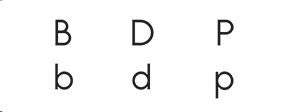If you look at q p d and b, it’s no wonder emerging readers tend to confuse them. These letters have similar forms, and many students who are learning to read and write tend to reverse, rotate, or invert them. They are part of a group of letters known as visually confusing letters.
Visually Confusing Letters are any lowercase letters whose overall form is identical or similar to another lowercase letter’s form. This table shows the most frequently confused letters in the English alphabet:
| Visually Confusing Letters |
.png) |
Have you ever had a student read or write the word big instead of dig? Visually confusing letters cause errors in reading and writing, especially for emerging readers who have not yet fully mastered the lowercase alphabet. Educators need to take extra time to help students learn these letters.
An effective way to help students master these letters is to provide a cue card that displays pairs of uppercase and lowercase letters. Uppercase letters are more easily distinguishable, and students tend to master these letters first and more easily. Thus, when a visually confusing lowercase letter is grouped with its more easily distinguishable uppercase counterpart, students can more easily determine the correct letter.
For example, here is a cue card with uppercase and lowercase pairs for the visually confusing letters b, d, and p.

Provide a student with a cue card like this one and direct the student to use it whenever s/he reads or writes a word with one of the lowercase letters shown on the card. The student can confirm the lowercase letter on the bottom by connecting it to its more distinguishable uppercase form on the top. With enough repetition, the student will soon master the visually confusing letters and no longer need the cue card.
Free cue card templates (including a sample cue card for the letters b, d, and p) are available on our website, along detailed directions on how to use them. You can create custom cue cards and print them on labels or cardstock, or simply write the upper- and lowercase letter pairs on Post-it® notes.
Download the Free Cue Card Template and b-d-p Example to try this effective strategy with emerging readers who tend to confuse certain letters. The sooner your students can distinguish a d from a b, the sooner their reading and writing skills can take off.
 Share your student’s success story—nominate him or her for our Star of the Month award. Win a Barnes & Noble gift card for the student and a Read Naturally gift certificate for your class!
Share your student’s success story—nominate him or her for our Star of the Month award. Win a Barnes & Noble gift card for the student and a Read Naturally gift certificate for your class!
Post a New Comment